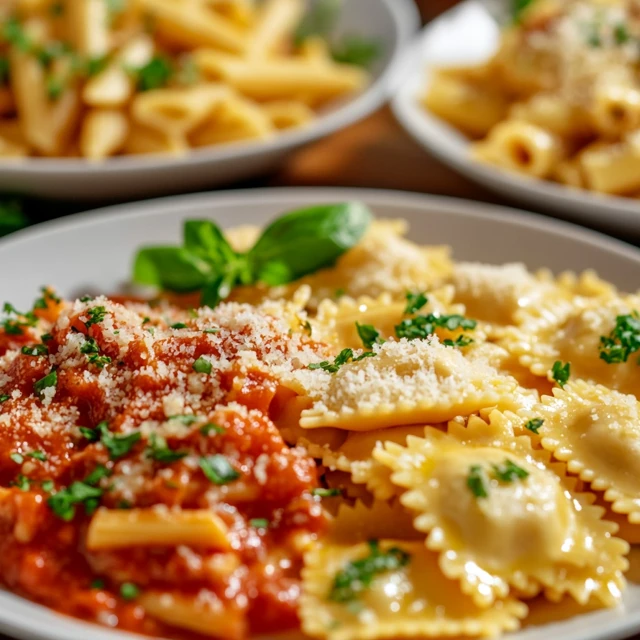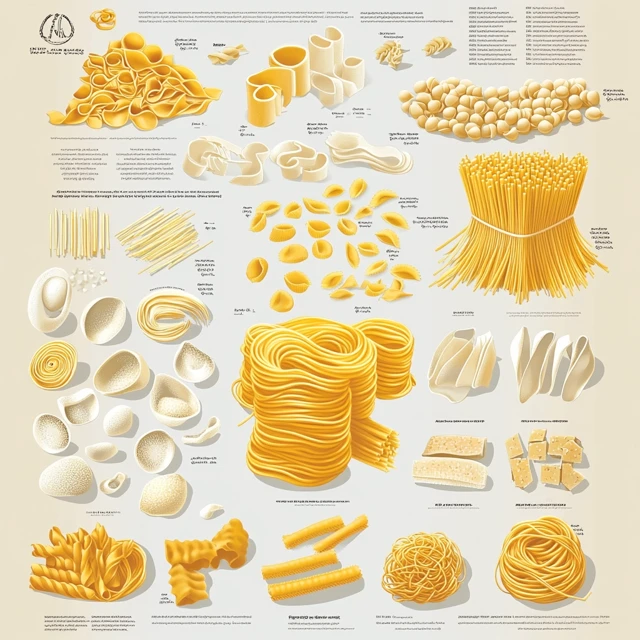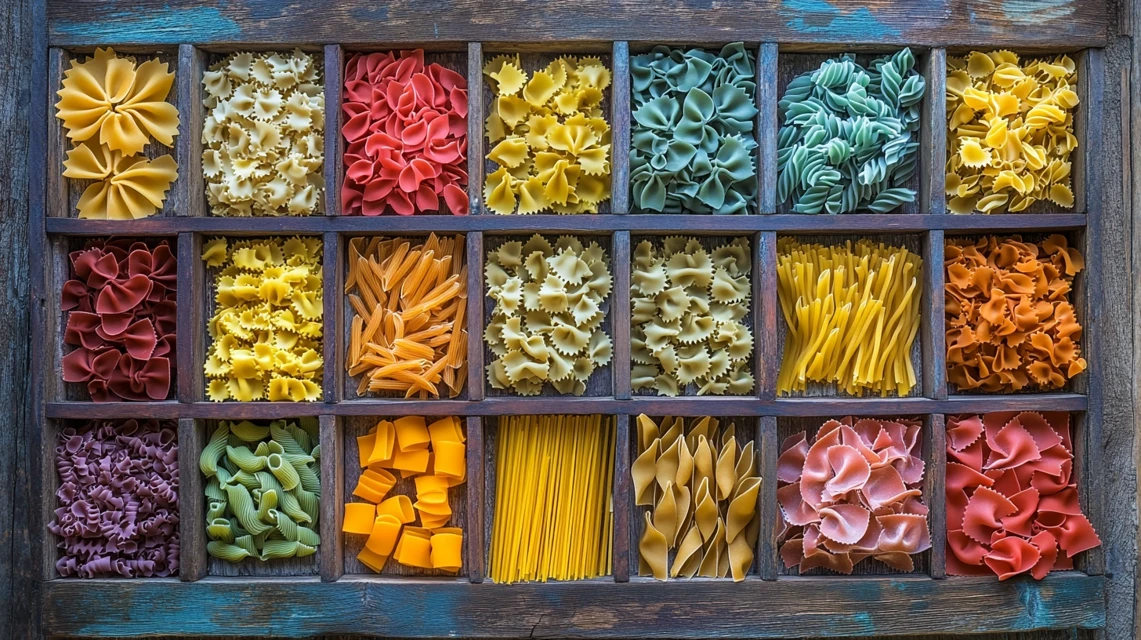What Are The 350 Types Of Pasta? Pasta enriches dining tables worldwide as a beloved staple food, offering an incredible variety of shapes, sizes, and textures. Furthermore, while most people regularly enjoy common types like spaghetti and penne, the pasta world actually encompasses over 350 different varieties, with each type featuring unique characteristics and specific uses. Therefore, thoroughly understanding these diverse pasta varieties will consequently help you select the perfect match for your next delicious meal.
Introduction to Pasta Varieties
Pasta has enriched global cuisine for centuries, delighting people across cultures and continents. Moreover, while pasta makers create it from simple ingredients—flour, water, and sometimes eggs—the distinctive shape and texture of each pasta type consequently transforms how it interacts with sauces and other ingredients.
How Pasta Developed Over Time
Pasta’s rich history extends back thousands of years, with early versions first emerging in both Asian and Mediterranean cultures. Furthermore, Italian cooks and artisans excel at refining pasta-making techniques and consequently have created the wide range of shapes we enjoy today. Additionally, throughout generations, regional preferences and distinctive cooking methods have naturally influenced chefs and pasta makers to develop new and unique pasta types, thus contributing to the extraordinary variety we see in modern times.
Key historical influences include:
- Ancient Rome: Early forms of pasta-like dishes made with grains and water.
- Medieval Italy: Introduction of egg pasta and more intricate shapes.
- Modern Innovations: Industrial production led to a greater variety of pasta shapes and styles.
Why Are There So Many Types of Pasta?
With over 350 types of pasta, it’s natural to wonder why so many varieties exist. The main reason lies in regional differences and the way pasta pairs with specific sauces and ingredients. Some of the key factors influencing pasta variety include:
- Regional Cuisine: Different regions in Italy have their own traditional pasta types. Northern Italy prefers egg-based pasta like tagliatelle, while Southern Italy is known for dried, durum wheat pasta like penne.
- Sauce Compatibility: Certain pasta shapes hold thick sauces better, while others work best with lighter, oil-based sauces.
- Texture Preferences: Some people prefer smooth pasta, while others enjoy ridged varieties that capture sauce more effectively.
- Cultural Influence: Over time, new pasta shapes have been created to suit changing tastes and culinary trends.
Each pasta shape serves a unique purpose, making it ideal for specific dishes and preparations.
check out this https://eassyrecipes.com/category/dinner/
Classification of Pasta by Shape
Pasta is often classified based on its shape, which determines how it should be cooked and served. The main categories include long, short, stuffed, flat, and tube pasta.
Long Pasta Varieties
Long pasta is known for its thin, elongated shape that pairs well with smooth and light sauces. Here are some of the most popular types:
1. Spaghetti
- A classic long pasta with a round shape.
- Best paired with tomato-based sauces, olive oil, or light cream sauces.
- Common dishes: Spaghetti Bolognese, Spaghetti Carbonara.
2. Linguine
- Slightly wider and flatter than spaghetti.
- Works well with seafood-based sauces and light olive oil-based dressings.
- Common dishes: Linguine with clam sauce, pesto linguine.
3. Fettuccine
- Wide, ribbon-like pasta often used in creamy sauces.
- Ideal for thick, rich sauces like Alfredo.
- Common dishes: Fettuccine Alfredo, creamy mushroom fettuccine.
Long pasta is best suited for swirling onto forks and allowing sauces to coat evenly.
Short Pasta Varieties

Short pasta types are ideal for hearty, chunky sauces and baked dishes. Their small size and sturdy shape help hold sauces well.
1. Penne
- Tube-shaped pasta with diagonal cuts at the ends.
- Great for holding thick and creamy sauces.
- Common dishes: Penne alla Vodka, Baked Penne.
2. Rigatoni
- Large, ridged tubes that hold sauces inside.
- Best for meaty or chunky vegetable sauces.
- Common dishes: Rigatoni Bolognese, Rigatoni with sausage.
3. Farfalle (Bowtie Pasta)
- Shaped like little bowties, ideal for salads and light sauces.
- Works well with creamy and cheesy dishes.
- Common dishes: Farfalle with creamy Alfredo, pasta salad.
Short pasta is perfect for baked dishes, salads, and rich, chunky sauces.
check out this https://eassyrecipes.com/category/dinner/
Stuffed Pasta Varieties
Stuffed pasta offers a particularly delicious twist on traditional pasta varieties by expertly incorporating flavorful fillings like creamy cheese, savory meat, and fresh vegetables. Furthermore, chefs and home cooks typically pair these distinctive pasta types with light, delicate sauces, thus allowing the rich, complex flavors of the filling to consequently shine through and take center stage.
1. Ravioli
Ravioli are square or round pasta pockets filled with various ingredients, such as ricotta cheese, spinach, or ground meat. They are often served with simple sauces that enhance their flavors.
Best uses for ravioli:
- Light tomato or marinara sauce
- Sage butter sauce
- Creamy Alfredo sauce
Popular dishes: Spinach and ricotta ravioli, lobster ravioli in cream sauce.
2. Tortellini
Tortellini are small, ring-shaped pasta, traditionally stuffed with a mixture of cheese, meat, or vegetables. They can be served in broths, light sauces, or as part of salads.
Best uses for tortellini:
- Broths like chicken or vegetable stock
- Pesto sauce
- Cream-based sauces
Popular dishes: Tortellini soup, cheese tortellini with marinara sauce.
3. Cannelloni
Cannelloni features large pasta tubes that chefs specifically design for stuffing, and home cooks typically fill them with rich ingredients before baking with sauce and cheese. Furthermore, these versatile tubes particularly excel when filled with creamy ricotta, fresh spinach, or savory ground meat.
Best uses for cannelloni:
- Tomato-based sauces such as marinara
- Creamy béchamel sauce
- Pesto drizzles
Popular dishes: Ricotta and spinach-stuffed cannelloni, baked cannelloni with meat sauce.
Stuffed pasta adds elegance to meals and consequently shines at special occasions due to its particularly rich and complex flavors. Moreover, home cooks and chefs alike often save these luxurious pasta varieties for celebrations, thus making them even more memorable.
Flat Pasta Varieties
Flat pasta features a broad, wide surface, consequently making it ideal for layered dishes and thick sauces. Furthermore, these pasta types excel at supporting heavy ingredients and therefore create multiple delightful textures in a single bite.
1. Lasagna
Lasagna consists of wide, flat sheets that chefs and home cooks expertly layer with sauce, cheese, and flavorful fillings such as meat or vegetables. Moreover, this classic pasta variety has consequently become one of the most famous and beloved baked pasta dishes throughout the world.
Best uses for lasagna:
- Meat-based Bolognese sauce
- Ricotta and spinach fillings
- Bechamel or Alfredo sauce
Popular dishes: Classic beef lasagna, vegetarian lasagna with zucchini and ricotta.
2. Pappardelle
Pappardelle features broad, elegant ribbon-like strands that consequently work exceptionally well with hearty, thick sauces. Moreover, its generously wide surface area particularly excels at holding rich, meaty sauces, thus making it an especially popular choice for slow-cooked dishes that demand a substantial pasta to complement their robust flavors.
Best uses for pappardelle:
- Rich ragù sauces
- Mushroom cream sauces
- Game meat stews
Popular dishes: Pappardelle with wild boar ragu, pappardelle with creamy truffle sauce.
3. Tagliatelle
Tagliatelle is a long, ribbon-shaped pasta that is slightly thinner than pappardelle but still sturdy enough to hold thick sauces. It is commonly used in traditional Italian dishes.
Best uses for tagliatelle:
- Bolognese sauce
- Cream-based truffle sauce
- Simple butter and parmesan
Popular dishes: Tagliatelle al ragù, tagliatelle with seafood and lemon zest.
Flat pasta is a great option for those who enjoy hearty, rich meals with layers of flavor.
check out this https://eassyrecipes.com/category/dinner/
Tube Pasta Varieties

Tube pasta varieties are hollow, allowing sauces to fill the inside and cling to the exterior, creating a delicious bite packed with flavor. These pasta types work best with thick, chunky sauces.
1. Ziti
Ziti is a medium-sized, smooth tube pasta that is commonly used in baked dishes. Its hollow center holds sauce well, making it a perfect choice for rich, cheesy recipes.
Best uses for ziti:
- Baked pasta dishes with marinara sauce
- Creamy Alfredo sauces
- Meat sauce combinations
Popular dishes: Baked ziti with ricotta and mozzarella, ziti with meat sauce.
2. Manicotti
Manicotti are large tubes meant to be stuffed with cheese or meat fillings, similar to cannelloni. They are typically baked with a hearty sauce and topped with cheese.
Best uses for manicotti:
- Ricotta and spinach filling
- Ground meat and marinara sauce
- Alfredo sauce with herbs
Popular dishes: Baked manicotti with béchamel, stuffed manicotti with ricotta.
3. Paccheri
Paccheri are large, wide tubes, often stuffed or used in hearty dishes with thick sauces. They are known for their chewy texture and ability to hold flavorful fillings.
Best uses for paccheri:
- Tomato and sausage sauce
- Seafood-based sauces
- Creamy mushroom sauces
Popular dishes: Paccheri with sausage ragu, paccheri with creamy truffle sauce.
Tube pasta varieties are perfect for comfort food dishes that require thick, flavorful sauces to shine.
Decorative and Specialty Pasta Varieties
Some pasta shapes are designed to be visually appealing while still functional. These specialty pasta varieties add a fun and decorative element to dishes.
1. Rotelle (Wagon Wheels)
Rotelle pasta is shaped like wagon wheels, making it fun for kids and great for holding chunky sauces.
Best uses for rotelle:
- Pasta salads with colorful vegetables
- Cheesy baked dishes
- Thick meat sauces
Popular dishes: Rotelle pasta salad, rotelle with cheese sauce.
2. Orecchiette (Little Ears)
Orecchiette, meaning “little ears” in Italian, are small, round pasta shapes with a slight curve that helps them hold sauce well.
Best uses for orecchiette:
- Sausage and broccoli sauce
- Pesto with cherry tomatoes
- Creamy ricotta and spinach sauces
Popular dishes: Orecchiette with sausage and broccoli rabe, orecchiette with creamy pesto.
3. Trofie (Twisted Pasta)
Trofie are short, twisted pasta pieces that pair well with thick, creamy sauces. They are commonly used in traditional Ligurian cuisine.
Best uses for trofie:
- Classic pesto sauces
- Butter and cheese sauces
- Light tomato sauces
Popular dishes: Trofie al pesto, trofie with sun-dried tomato sauce.
FAQs About Pasta Varieties
Pasta comes in an extraordinarily fascinating range of shapes and sizes, with each type specifically suited to different dishes and rich culinary traditions. Moreover, while many people express curiosity about the exact number of pasta varieties that exist, they furthermore wonder whether this number continues to grow over time. Therefore, to help clarify these intriguing questions, below we explore and thoroughly answer some of the most frequently asked questions about the diverse world of pasta varieties.
What Are the 350 Different Types of Pasta?
Over 350 officially recognized pasta types exist worldwide, with each one offering unique characteristics and cooking applications. Furthermore, chefs and home cooks typically group these diverse varieties into several distinct categories based on their distinctive shapes and specific uses. Therefore, to help you understand these varieties better, let’s explore some of the most well-known pasta types, including:
1. Long Pasta – Best for light sauces and twirling.
- Spaghetti – Thin and round, pairs well with tomato or oil-based sauces.
- Linguine – Slightly wider and flat, perfect for seafood dishes.
- Fettuccine – Thick, flat ribbons that hold creamy sauces well.
2. Short Pasta – Great for hearty sauces and baked dishes.
- Penne – Tube-shaped, perfect for creamy or tomato-based sauces.
- Rigatoni – Large ridged tubes that capture chunky sauces.
- Fusilli – Spiraled pasta that holds sauces in its twists.
3. Stuffed Pasta – Filled with delicious ingredients.
- Ravioli – Square pockets stuffed with cheese, meat, or vegetables.
- Tortellini – Small rings filled with savory ingredients.
- Cannelloni – Large tubes filled and baked with sauces.
4. Flat Pasta – Ideal for layered or saucy dishes.
- Lasagna – Wide sheets used for baked pasta dishes.
- Pappardelle – Broad ribbons that work well with thick meat sauces.
- Tagliatelle – Long, flat pasta used in traditional Italian recipes.
5. Specialty Pasta – Unique shapes for special dishes.
- Orecchiette – Small ear-shaped pasta, great for holding thick sauces.
- Rotelle – Wagon wheel shapes, fun for kids and pasta salads.
- Trofie – Twisted pasta, often used with pesto.
Each type of pasta has a specific texture and shape, making it the perfect match for different sauces and cooking styles.
Are There Over 300 Types of Pasta?
Yes, there are well over 300 pasta varieties, with new shapes being developed to suit modern culinary trends. The variety of pasta comes from different Italian regions, where each community has crafted its own unique styles based on local ingredients and cooking traditions.
The factors that contribute to the large number of pasta types include:
- Regional Influence: Different areas of Italy specialize in unique pasta styles. Northern regions favor egg-based pasta, while southern regions prefer durum wheat pasta.
- Sauce Pairing: Some pasta shapes work best with light sauces, while others are designed to hold thick, chunky sauces.
- Culinary Evolution: Over time, chefs and home cooks have created new pasta shapes to suit evolving tastes and dietary preferences.
Popular international pasta variations and gluten-free options have also contributed to the growing number of pasta types.
Are There 600 Types of Pasta?
While experts officially recognize around 350 varieties, interestingly, some sources consequently claim the existence of over 600 unique pasta shapes worldwide. Furthermore, this impressive number specifically includes numerous variations, cherished regional specialties, and moreover, modern innovations thoughtfully introduced by creative chefs and innovative food manufacturers.
Additionally, among these fascinating lesser-known pasta types that significantly contribute to this higher count, you’ll discover:
- Strozzapreti – This traditional hand-rolled pasta features a distinctively twisted shape, and thus remains particularly popular throughout central Italy.
- Busiate – Originally from Sicily, this elegant spiral-shaped pasta consequently pairs exceptionally well with the regional pesto Trapanese.
- Mafaldine – These sophisticated ribbon-like pasta strands showcase delicately ruffled edges, therefore making them ideal vessels for rich, creamy sauces.
- Casarecce – This unique short pasta incorporates a subtle twist, and subsequently plays a fundamental role in traditional Sicilian cuisine.
Indeed, this fascinating list continues to expand progressively as passionate pasta lovers enthusiastically experiment with innovative new shapes and creative ingredients.nts.
How Many Pasta Varieties Are There?
What Are The 350 Types Of Pasta? The exact number of pasta varieties interestingly varies depending on the source consulted. Moreover, while Italy officially recognizes approximately 350 different distinct pasta types, this number consequently grows much larger when you additionally include international adaptations, specialty diet variations, and unique homemade creations. Therefore, when considering all these diverse varieties together, the total number can easily surpass 600 different types of pasta.
Pasta varieties are classified based on:
- Shape and Size: Spaghetti (thin and long) vs. rigatoni (short and thick).
- Filling: Stuffed pasta like ravioli vs. plain pasta like penne.
- Ingredients: Traditional wheat pasta vs. gluten-free and vegetable-based options.
- Cooking Method: Some pasta types are better for baking, while others are suited for boiling and quick sauces.
This wide variety allows pasta to be a versatile dish enjoyed in countless ways across the globe.
Conclusion
Pasta represents far more than just a simple food; indeed, it opens up an entire world of flavors, shapes, and rich traditions. Moreover, with over 350 officially recognized pasta types and countless more variations thoughtfully created throughout the years, there consequently remains an endless array of possibilities to discover. Furthermore, whether you particularly enjoy the timeless appeal of classic spaghetti, the luxurious comfort of stuffed ravioli, or alternatively prefer unique specialty pasta varieties, there undoubtedly exists a perfect pasta type suited for every occasion and individual preference.
Therefore, by thoroughly understanding these diverse pasta varieties, you can subsequently choose precisely the right one for your next meal, thus ensuring not only a delicious but also an exceptionally satisfying culinary experience.

